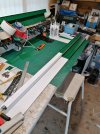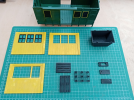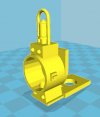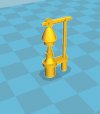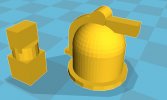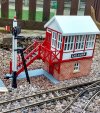musket the dog
Registered
Plastics by their nature are very complex. Just because two might be noted down as ABS or PLA does not mean that they will necessarily have the same properties. I would not be surprised if the ABS filaments being supplied by different suppliers are all slightly chemically different in some way. Usually a manufacturer's specific blend of the material is unique to them. More to the point the people supplying the filament won't be making the blends, that will probably come from BAYER, or BASF or whoever as a bag of plastic pellets. They are then free to mix whatever that like in with that bag. Usually to add colour, but it can include other materials to change properties such as the stiffness or mouldability. This will all have an effect on the actual mechanical properties of the final filament.
LGB use a plastic called Luran-S, which is just a brand name for a type of polymer known as ASA. ASA is commonly used in bare automotive body panels, mainly because of its increased UV resistance over ABS. There's nothing special about it per se, it's just more suitable. You can buy ASA filament, but again this won't necessarily yield the same results as an LGB moulding.
The type of 3D printing can have an effect too. The layered deposition type used by most of the home printers has a natural weakness in the fact the layers are essentially separate and stuck together while the polymer is still is its 'plastic' stage. You can pay a few companies to laser sinter powder for you, which will be slightly stronger than filament printing but still not quite up to an injection moulding. When I spent some time with the Red Bull F1 team back in 2010, they were using this method to print new gearbox gears overnight.
What I see missing from a lot of 3D printed parts is what you might consider 'good' plastic part design. When you have to plan for how to remove something from a injection mould and getting the design wrong might mean a whole batch of parts warping or some very expensive tool mods, you are forced to consider the design more. Obviously the same concerns don't apply to a home printed part. Plastic parts by their nature like uniform thicknesses and lots of support. If you look along the flat, long plain edge of an LGB open wagon, you can see the sink marks and warping caused by trying to force it to be a big open box. All plastic parts will warp and shrink as they cool, especially long flat things like the sides of buildings or wagons. In ordinary moulded part design I would get around this with thin ribs, walling the part or taking thickness out of the joints where 2 walls meet. It's easy to pick up an exisiting part, take the measurements, CAD up an exact replica and print a copy. Usually though, I think it needs to be a little more complicated
LGB use a plastic called Luran-S, which is just a brand name for a type of polymer known as ASA. ASA is commonly used in bare automotive body panels, mainly because of its increased UV resistance over ABS. There's nothing special about it per se, it's just more suitable. You can buy ASA filament, but again this won't necessarily yield the same results as an LGB moulding.
The type of 3D printing can have an effect too. The layered deposition type used by most of the home printers has a natural weakness in the fact the layers are essentially separate and stuck together while the polymer is still is its 'plastic' stage. You can pay a few companies to laser sinter powder for you, which will be slightly stronger than filament printing but still not quite up to an injection moulding. When I spent some time with the Red Bull F1 team back in 2010, they were using this method to print new gearbox gears overnight.
What I see missing from a lot of 3D printed parts is what you might consider 'good' plastic part design. When you have to plan for how to remove something from a injection mould and getting the design wrong might mean a whole batch of parts warping or some very expensive tool mods, you are forced to consider the design more. Obviously the same concerns don't apply to a home printed part. Plastic parts by their nature like uniform thicknesses and lots of support. If you look along the flat, long plain edge of an LGB open wagon, you can see the sink marks and warping caused by trying to force it to be a big open box. All plastic parts will warp and shrink as they cool, especially long flat things like the sides of buildings or wagons. In ordinary moulded part design I would get around this with thin ribs, walling the part or taking thickness out of the joints where 2 walls meet. It's easy to pick up an exisiting part, take the measurements, CAD up an exact replica and print a copy. Usually though, I think it needs to be a little more complicated

